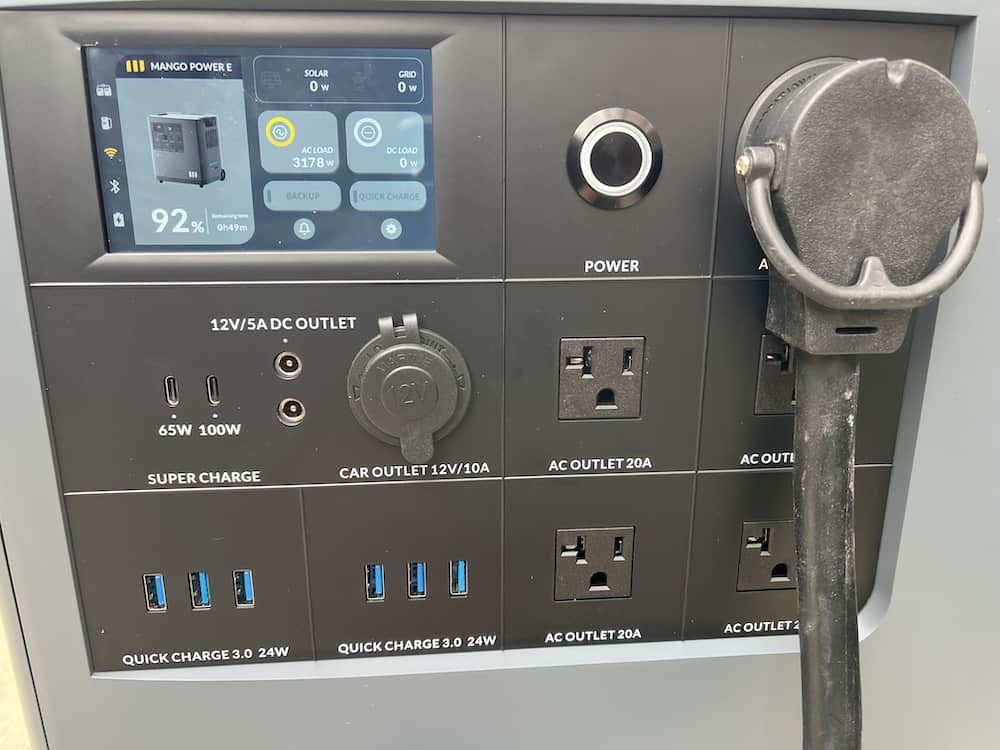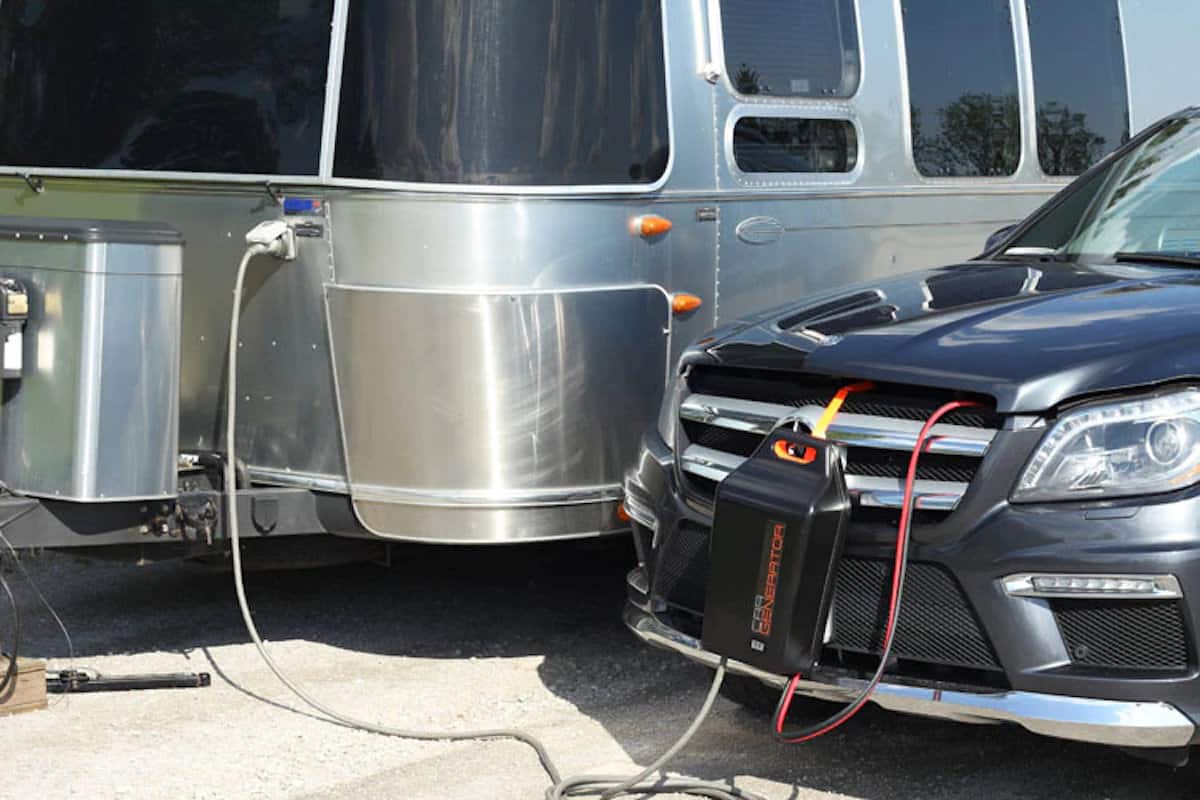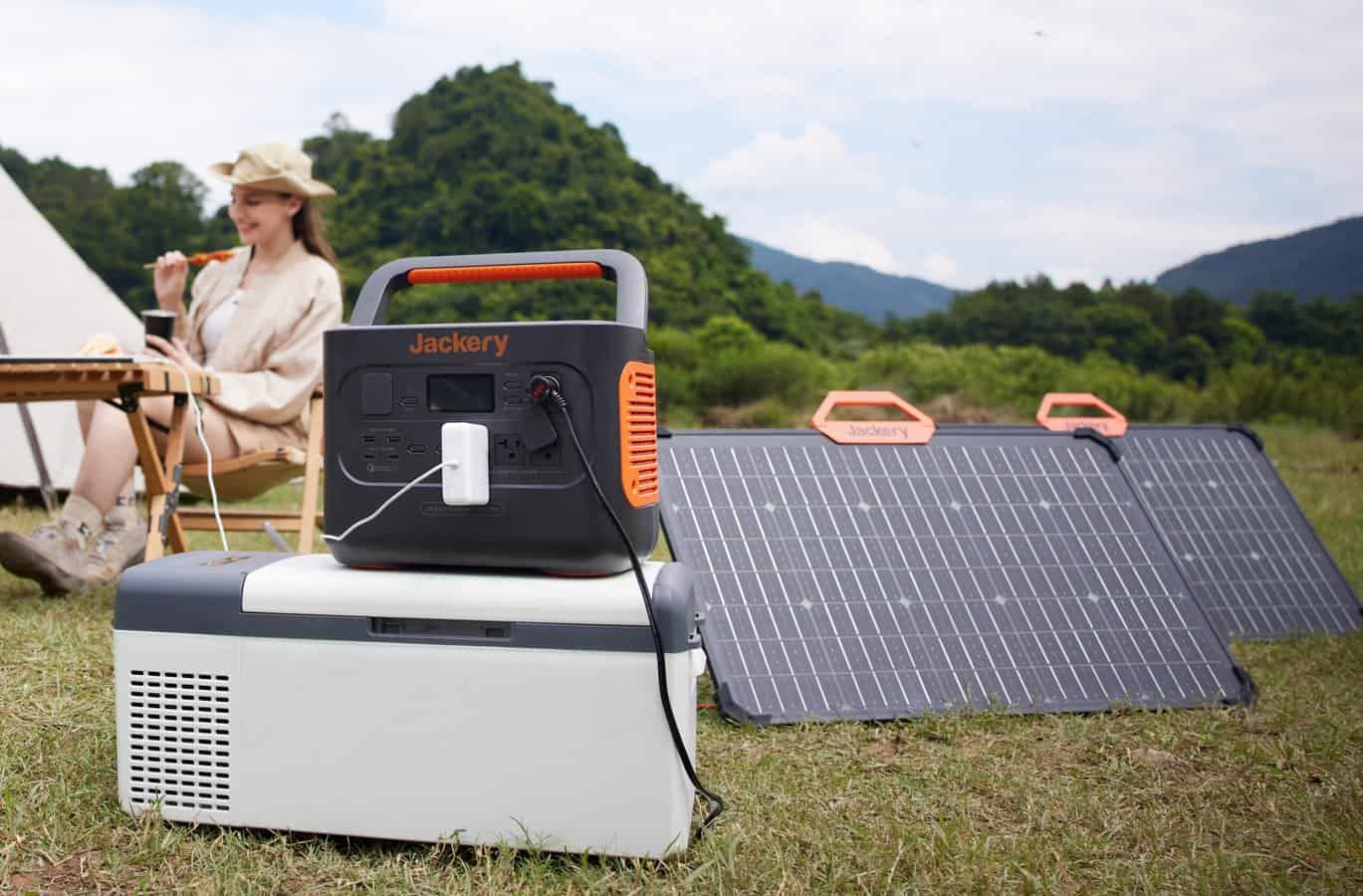
Sponsored by Mango Power
Mango Power E: The Perfect Solution for Portable Power Needs
The demand for powerful and portable RV power continues to increase each month. People are searching for backup power and off-grid camping solutions that are easy to transport. The Mango Power E Portable Power Station pushes all those buttons and the portability envelope.
The Mango Power E portable power station
One look at the Mango Power E will tell you a lot. Yes…that’s a 30-amp plug on the front. Yes, those are wheels and a handle. Four AC sockets, six USB-A ports, and a pair of high-power USB-C ports are rounded out with 12VDC outlets and a car (lighter-style) socket.
You can derive a sense of the overall scale from the size of that socket panel, quickly appreciating the Mango Power E’s 17.8-inch x 13.6-inch x 19.4-inch size and 100 lb. heft. On the side, a panel covers the charging cluster where the Mango can receive solar and AC inputs, provide an E-Link port to connect with other Power E’s, and an E+ Port where it can be charged from an EV charging station source.
The Mango Power E Home Backup and Portable Power Station can be charged in any combination of these ways and reach 80% of power in just 1-hour.
Portable power for RVers
The number of ways this portable power station can be used for RVers is seemingly endless. For starters, you have all the obvious uses: powering or charging laptops, phones, flashlights, fans, coffee pots, bottle warmers, ice makers, electric coolers…the list is endless. You can even power the dreaded breaker-busting hair dryer.
Take the Mango Power E outside and you have power for an air compressor to inflate tires, kayaks, and rafts. You can power an electric griddle, outdoor lighting, or a power washer. Anywhere you need power, or simply more power, the Power E is ready.
That 30-amp plug on the front, even for us 50-amp folks, opens up a whole new world of possibilities too. Imagine going off grid with your existing battery and solar setup and plugging your RV into the Mango Power Station to supplement that setup. How nice would it be to have supplemental power during those no-generator hours at night? Hooking up the Mango Power E is like adding a second battery bank for your off-grid needs.
Mango E Power Station gives peace of mind to RVers when boondocking/off-grid, ensuring power availability in the morning despite battery capacity miscalculations.
Backup power for homeowners
Battery solutions have replaced gas or diesel generators due to frequent home power outages and restrictions.
The Mango Power E is just as comfortable in your home as it is at the campsite, providing the same 3500Wh of backup power. Here, again, those wheels and handle come to the rescue, making it easy to move the Power E where you need it most. Whether it’s keeping phones and flashlights charged, a CPAP machine (75 hours), or just keeping the TV and Xbox running so the kids will stay quiet and calm during the outage.
With all of those available ports, you’ll have plenty of room left to keep your phone charged, a heater running in the winter, or an air conditioner in the summer to stay cool. The 3500Wh Mango E Power Station can keep a refrigerator running for two full days.
Connecting additional power to the Mango Power E
Those who choose this beefy power station for home power backup might be interested in adding an additional battery pack.
“Battery pack” is such a misleading term here…The Mango Power E Expansion Battery doubles its already massive capacity to a staggering 7000Wh. As you might guess, it nearly doubles the weight as well. Designed to stack on top of the original Power E, it becomes a formidable home backup pairing.
Should you need 240 volts during an emergency, perhaps to use an electric oven or satisfy an unquenchable desire to dry clothes during a power outage, having that second battery pack allows you to connect the Mango Power mSocket Pro, which taps into each 120V leg of each Mango unit to create 240 volts.
The Mango mPanel connects units to your home’s electrical panel for backup power when you lose power. Two Mango E’s plus their expansion battery pack provide 14,000Wh of power, controlled by the Mango Power Mobile App.

Specifications
Here are the most important general specifications for the Mango Power E. For a detailed list of specifications, visit their website.
- Weight – 100 lbs
- Size – 17.8 inch x 13.6 inch x 19.4 inch
- Warranty – 5 years
- Running Noise – < 40dB under no-load, <51dB under full-load
- Battery – CATL LiFePO4
- Battery Capacity – 3.53 kWh
- Power – 3500W
- Screen – 4.3 inches / 480 x 800 / 16.7M colors
- Safety – Built-in safety check system and over-voltage protection
Mango Power E Solar Hookups
I admit to having a fascination with portable solar power. Note that I do not have solar on my big diesel pusher. I have a 100-gallon fuel tank, 6 big house batteries, and a 10k generator. We rarely, if ever, go off-grid. I don’t need solar, which means I haven’t gone all-in like my friends Tom & Stacie from RV Texas Y’all.
The Mango Power E has a standard MC4 solar connector that is compatible with their 200W Mango “Solar Move” folding panel. Other portable solar panels can work, but fitting combinations must be correct. The user tested different combinations and was able to connect a few 200W panels to test the Power E’s solar functionality.
The small touches
In handling the Mango Power E Portable Power Station, I was always on the lookout for the little touches that might separate the Mango from other units. I was pleasantly surprised to find that the roller wheels actually had true, sealed wheel bearings…the kind you would find on a well-made skateboard. I didn’t check to see if they were German speed bearings or hit any half-pipes with the Mango E, but it rolled nicely around my home and driveway for proper testing.
The Power E has a collapsible handle and two handles for lifting. The case is well-made and ventilated for the battery pack, which comes with a five-year warranty.
Connecting the mobile app
The Mango Power E can be controlled through a mobile application. By connecting the device to your phone through Bluetooth, it can also connect to Wi-Fi to check for updates.
To connect your Mango Power E to the mobile app, you will be adding the device manually and entering the serial number, which is easily found by pressing the branded portion of the touch screen. The app will automatically connect to the Power E with Bluetooth, but in order to connect and control the power station, you’ll need to connect the internet parameters as well. I found this video very helpful.
Real world testing
Although one of the tests I always perform on portable power stations is to run a portable Toshiba air conditioner we have for as long as it will run, this time of year it was going to be a space heater! I also wanted to perform a test on my 50-amp diesel pusher.
The experiment revealed that the rooftop AC/heat pump units rely on the onboard diesel generator. To trick the RV into running them, a 50-amp cord was plugged into a dogbone to reduce it to 30-amp and connected to the Mango Power E.
The goal of that test was to see how long I could run one of my rooftop units, in this case the heat pump functionality, without having to run the generator. No one wants to spend their entire camping trip listening to the generator, nor is it always easy or economical to add solar to an RV or replace your house batteries. With the Mango Power E, I was getting a taste of both.
Stand-alone power testing
Although this testing occurred in the spring, it was also during a major cold snap, even here in the South. Rather than run a portable air conditioner, I ran a 1400-watt space heater. Bringing it outside in 49-degree weather proved to be an optimal test, as it would never shut off.
Using Mango Power E app, I found that the space heater used 1403W for 124 minutes at full heat and fan. RVers can have warmth for hours or days in small RVs with similar space heaters that cycle off when not in use, depending on temperature and sun heat absorption.

Powering a diesel pusher
I managed to deceive my RV into believing it was connected and operated the rooftop AC unit in heat pump mode with success. By significantly increasing the desired temperature and leaving the door and a large window open, I made it nearly impossible for the unit to heat up the interior temperature adequately, causing it to operate continuously.
I was able to run the rooftop heat pump for 51 minutes using this method non-stop at full fan speed. In a normal situation with doors and windows closed, the unit would have shut off until temperatures changed again. I noted during the test cycle that the Mango Power E was consistently delivering over 3200W. Whether hot or cold, the Mango Power E gives me an advantage I did not have before, with greater potential for boondocking.
Had I decided that I wanted to charge the Mango Power E via the onboard generator, I could have plugged the power station into one of the AC outlets on my RV and run the generator for an hour or so.
Solar power
My solar panels gave an incoming power of 460W, same as my AC connection, when I used a custom cable to test them.
Note that these panels generated 88.4 volts DC into the solar input of the Mango. This was 26.4 volts above the minimum of 60 volts DC needed to register as a viable input for the Power E. That additional solar power can radically change the amount of power available on the Power E when in use.
Conclusion
The Mango Power E portable power station defies size, portability, and power limitations. It presents a compelling substitute to solar additions or RV battery replacements, and offers numerous advantages.
There are huge advantages for full-time RVers. However, part-time RVers can also find handy uses for emergency power around the home too. See the entire collection of Mango Power options at mangopower.com.





Hi Sales/Supplier
We would like to request for a quote of these following item,
The Mango Power E portable power station
Quantity : 50 pieces
Kindly get back to us with the quote and the lead’s time.
Regards
Richard Walker Jr
Head of Supply Chain & Procurement,
SHAWS CORPORATION